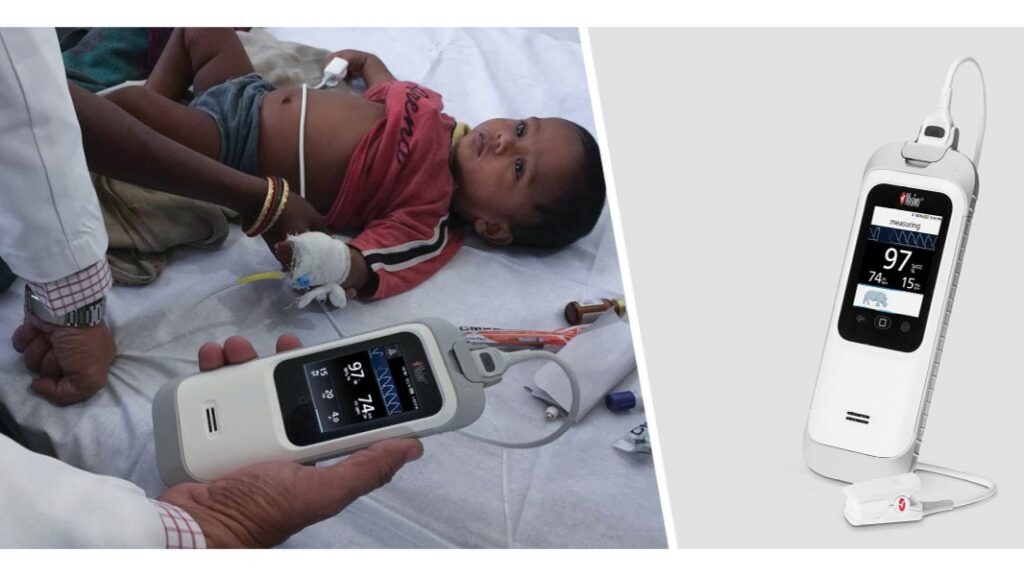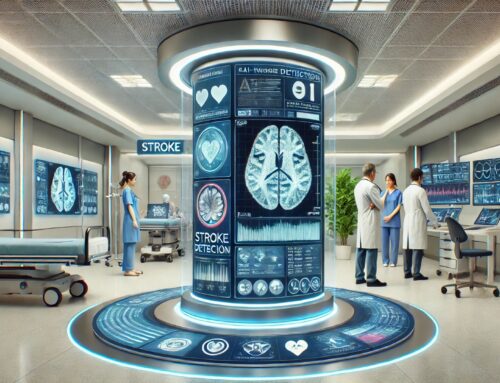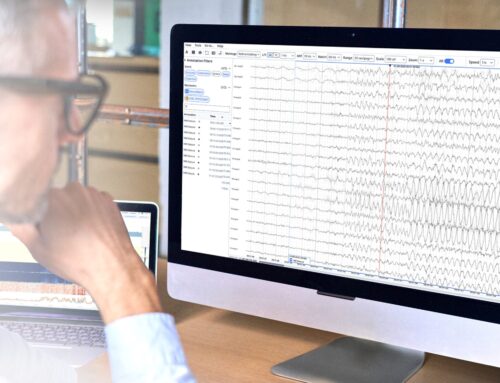Masimo has announced the results of a prospective, observational study published in Acta Paediatrica in which researchers from the Hospital for Sick Children in Toronto evaluated the accuracy of plethysmographic respiration rate measurement (RRp®) using Masimo Rad-G™, a rugged, handheld device, on malnourished, hospitalized children in Nigeria.1

Noting that in resource-limited environments, respiration rate (RR) measurement is often used to directly inform medical decisions for children with respiratory problems, but that manual RR counting “remains a challenge,” Dr. Nancy Dale and colleagues investigated whether a technological solution might provide a useful alternative to manual counting. To make the evaluation, the researchers compared simultaneous device measurements and nurse-measured manual RR counts on malnourished children. The device chosen was the Masimo Rad-G, which uses a pulse oximetry sensor to measure both oxygen saturation and RRp, and which has been shown to provide good agreement between RRp and pediatrician-measured RR.2 They enrolled 514 children, aged 6 to 59 months, who were hospitalized between July 2019 and May 2020, in Borno State, Nigeria. Study nurses were trained to operate Rad-G and also perform manual RR counts as part of twice-daily patient assessment. RR was manually counted for 60 seconds while Rad-G simultaneously measured RRp via a sensor attached to the patient’s toe, and both measurements were recorded.
Analyzing the 6,889 paired RR measurements, the researchers found that the mean Rad-G RRp reading was 1.3 bpm (95% confidence interval 1.2 – 1.4 bpm) higher than the mean manual RR value. The mean absolute difference between the two methods was 4.4 bpm (95% CI 4.3 – 4.5 bpm). When RR was classified as either “normal” or “fast” breathing (using WHO pneumonia thresholds), the two methods resulted in the same classification 84% of the time. When RR was classified according to BedsidePEWS RR sub-scoring (a 4-point scale), 80% of the scores were the same, and 99.3% were within 1 point.
The researchers concluded that their findings “highlight the potential clinical impact of changing practice from manual to automated RR count. Clinical implementation of the device should be carefully monitored to measure impact on patient outcomes.”
Study co-author Dr. Stanley Zlotkin commented, “Technical solutions to improve clinical care are laudable. We look forward to continuing this research.”
RRp is one of multiple RR monitoring modalities offered by Masimo, which also include acoustic respiration rate (RRa®) and NomoLine® capnography (RRc™), helping clinicians ensure they have the most suitable tool for each patient scenario.
First developed in partnership with The Bill & Melinda Gates Foundation, Rad-G is a rugged, handheld device that provides clinically proven Masimo SET® pulse oximetry, respiration rate (RRp), and other important parameters. With its long-lasting rechargeable battery, robust rubber casing, and light weight, Rad-G makes it easier for clinicians to quickly assess patients and make informed care decisions anywhere pulse oximetry or vital signs checking is needed in a compact, portable form factor. Coupled with the universal Mini-Clip™ pulse oximeter sensor to provide the ultimate in handheld versatility, Rad-G can be used in a variety of settings, including limited-resource environments, both indoors and in the field.
In the U.S., RRp is 510(k) cleared for patients greater than two years old.
@Masimo | #Masimo
About Masimo
Masimo (NASDAQ: MASI) is a global medical technology company that develops and produces a wide array of industry-leading monitoring technologies, including innovative measurements, sensors, patient monitors, and automation and connectivity solutions. Our mission is to improve patient outcomes and reduce the cost of care. Masimo SET® Measure-through Motion and Low Perfusion™ pulse oximetry, introduced in 1995, has been shown in over 100 independent and objective studies to outperform other pulse oximetry technologies.3 Masimo SET® has also been shown to help clinicians reduce severe retinopathy of prematurity in neonates,4 improve CCHD screening in newborns,5 and, when used for continuous monitoring with Masimo Patient SafetyNet™ in post-surgical wards, reduce rapid response team activations, ICU transfers, and costs.6-9 Masimo SET® is estimated to be used on more than 200 million patients in leading hospitals and other healthcare settings around the world,10 and is the primary pulse oximetry at 9 of the top 10 hospitals according to the 2020-21 U.S. News and World Report Best Hospitals Honor Roll.11 Masimo continues to refine SET® and in 2018, announced that SpO2 accuracy on RD SET® sensors during conditions of motion has been significantly improved, providing clinicians with even greater confidence that the SpO2 values they rely on accurately reflect a patient’s physiological status. In 2005, Masimo introduced rainbow® Pulse CO-Oximetry technology, allowing noninvasive and continuous monitoring of blood constituents that previously could only be measured invasively, including total hemoglobin (SpHb®), oxygen content (SpOC™), carboxyhemoglobin (SpCO®), methemoglobin (SpMet®), Pleth Variability Index (PVi®), RPVi™ (rainbow® PVi), and Oxygen Reserve Index (ORi™). In 2013, Masimo introduced the Root® Patient Monitoring and Connectivity Platform, built from the ground up to be as flexible and expandable as possible to facilitate the addition of other Masimo and third-party monitoring technologies; key Masimo additions include Next Generation SedLine® Brain Function Monitoring, O3® Regional Oximetry, and ISA™ Capnography with NomoLine® sampling lines. Masimo’s family of continuous and spot-check monitoring Pulse CO-Oximeters® includes devices designed for use in a variety of clinical and non-clinical scenarios, including tetherless, wearable technology, such as Radius-7® and Radius PPG™, portable devices like Rad-67™, fingertip pulse oximeters like MightySat® Rx, and devices available for use both in the hospital and at home, such as Rad-97®. Masimo hospital automation and connectivity solutions are centered around the Masimo Hospital Automation™ platform, and include Iris® Gateway, iSirona™, Patient SafetyNet, Replica™, Halo ION™, UniView™, UniView :60™, and Masimo SafetyNet™. Additional information about Masimo and its products may be found at www.masimo.com. Published clinical studies on Masimo products can be found at www.masimo.com/evidence/featured-studies/feature/.
ORi and RPVi have not received FDA 510(k) clearance and are not available for sale in the United States. The use of the trademark Patient SafetyNet is under license from University HealthSystem Consortium.
References
- Dale N, Parshuram C, Tomlinson G, Shepherd S, Ashir GM, Maryah LB, Zlotkin S. Performance of automated versus nurse-measured respiratory rate measurements in hospitalized malnourished children. Acta Paediatr 2021. DOI: https://doi.org/10.1111/apa.15781.
- Alwadhi V, Sarin E, Kuma P et al. Measuring accuracy of plethysmography based respiratory rate measurement using pulse oximeter at a tertiary hospital in India. Pneumonia 2020;12:4. DOI: https://doi.org/10.1186/s41479-020-00067-2.
- Published clinical studies on pulse oximetry and the benefits of Masimo SET® can be found on our website at http://www.masimo.com. Comparative studies include independent and objective studies which are comprised of abstracts presented at scientific meetings and peer-reviewed journal articles.
- Castillo A et al. Prevention of Retinopathy of Prematurity in Preterm Infants through Changes in Clinical Practice and SpO2 Technology. Acta Paediatr. 2011 Feb;100(2):188-92.
- de-Wahl Granelli A et al. Impact of pulse oximetry screening on the detection of duct dependent congenital heart disease: a Swedish prospective screening study in 39,821 newborns. BMJ. 2009;Jan 8;338.
- Taenzer A et al. Impact of pulse oximetry surveillance on rescue events and intensive care unit transfers: a before-and-after concurrence study. Anesthesiology. 2010:112(2):282-287.
- Taenzer A et al. Postoperative Monitoring – The Dartmouth Experience. Anesthesia Patient Safety Foundation Newsletter. Spring-Summer 2012.
- McGrath S et al. Surveillance Monitoring Management for General Care Units: Strategy, Design, and Implementation. The Joint Commission Journal on Quality and Patient Safety. 2016 Jul;42(7):293-302.
- McGrath S et al. Inpatient Respiratory Arrest Associated With Sedative and Analgesic Medications: Impact of Continuous Monitoring on Patient Mortality and Severe Morbidity. J Patient Saf. 2020 14 Mar. DOI: 10.1097/PTS.0000000000000696.
- Estimate: Masimo data on file.
- http://health.usnews.com/health-care/best-hospitals/articles/best-hospitals-honor-roll-and-overview.












